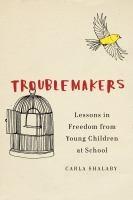
A fascinating and quietly powerful book.
I can't remember for sure, but I believe this was recommended to me by a high school teacher even though the four children at its center are first graders; its wisdom is that widely applicable. I even kept mentally applying its situations to my workplace manager-employee relationships. It's something I recommend for all educators, parents, and managers--to anyone with power over others.
Troublemakers struck me with particular relevance and immediacy because my two children are currently in kindergarten and first grade and have been known to cause a bit of trouble. My writing of this review was delayed an hour for a parent-teacher conference for the older one, which we literally just finished. In reference to our boys' (mis)behavior, our teacher called them "free spirits." Their behavior is sometimes misbehavior because they don't always comply with the requirements of school culture. I mention this because freedom is the core value at the heart of Shalaby's concerns.
Her book is an effort to reframe the idea of school behavioral expectations to include an understanding of students as full, free human beings, not mere students narrowly defined by a need for them to comply. Schools forcefully require students to conform to the setting, with coercion whenever necessary. She encourages teachers to see disruptive behavior not as a problem with the students, but as students attempting to communicate a problem with the demands the setting is making on them. To understand what students need and allow them to be free people in creating a community of learners.
Shalaby makes a case study of four different first-grade "troublemakers" at two different schools, applying her philosophy through her observations of them. She sees the values behind the behaviors that cause them so much trouble.
Families may model, teach, and value ways of being that they consider not only unproblematic, but actively healthy--like Zora learning to be unique and proud, Sean learning to question and argue, Lucas craving freedom and choice, and Marcus choosing not to be independent. But these ways of being sometimes get systematically punished by school. It is amazing, and disturbing, how early this process begins. These children have barely been alive seven years and already they have been identified as problems.
What she sees:
These alternate images allow us to view children as complex and beautiful human beings rather than caricatures of troublemakers. Their humanness encourages us to try to understand their difficult behavior through a more generous lens--a lens that treats trouble-making as a verb rather than a noun. As a noun, a troublemaker is a kind of person--an identity encoded in and imprinted on individual bodies. It locates the problem of noncompliance in people, fogging our view of the social and cultural production of trouble. By contrast, we can instead treat trouble-making as a verb--a process, an action, a system. We can ask, How does trouble get made as these children interact with school? Such a question redirects our attention away from "fixing" people whom we assume to be broken and instead toward addressing the harms that seek to break them.
Schools are a particularly harmful institution for young people. Trouble gets made because schools engender it, exclude it, and ultimately work hard to simply erase it. Schools try to make trouble invisible, most often by attempting to eliminate the young people who are working so hard to make it visible.
Shalaby's ideas felt a bit nebulous to me at the start of the book; I liked the idea of what she was saying, but didn't feel completely sure what it was. Even by the end of the first case study, I wasn't sure I could articulate her point. But as I carried on her message sunk in deeper and became clearer, and by her conclusion I had completely reached her wavelength. I reached her conviction.
I hope her ideas sunk deep enough to make me more effective in my work with youth at the library, make me a better parent, and make me a better advocate for my kids.
